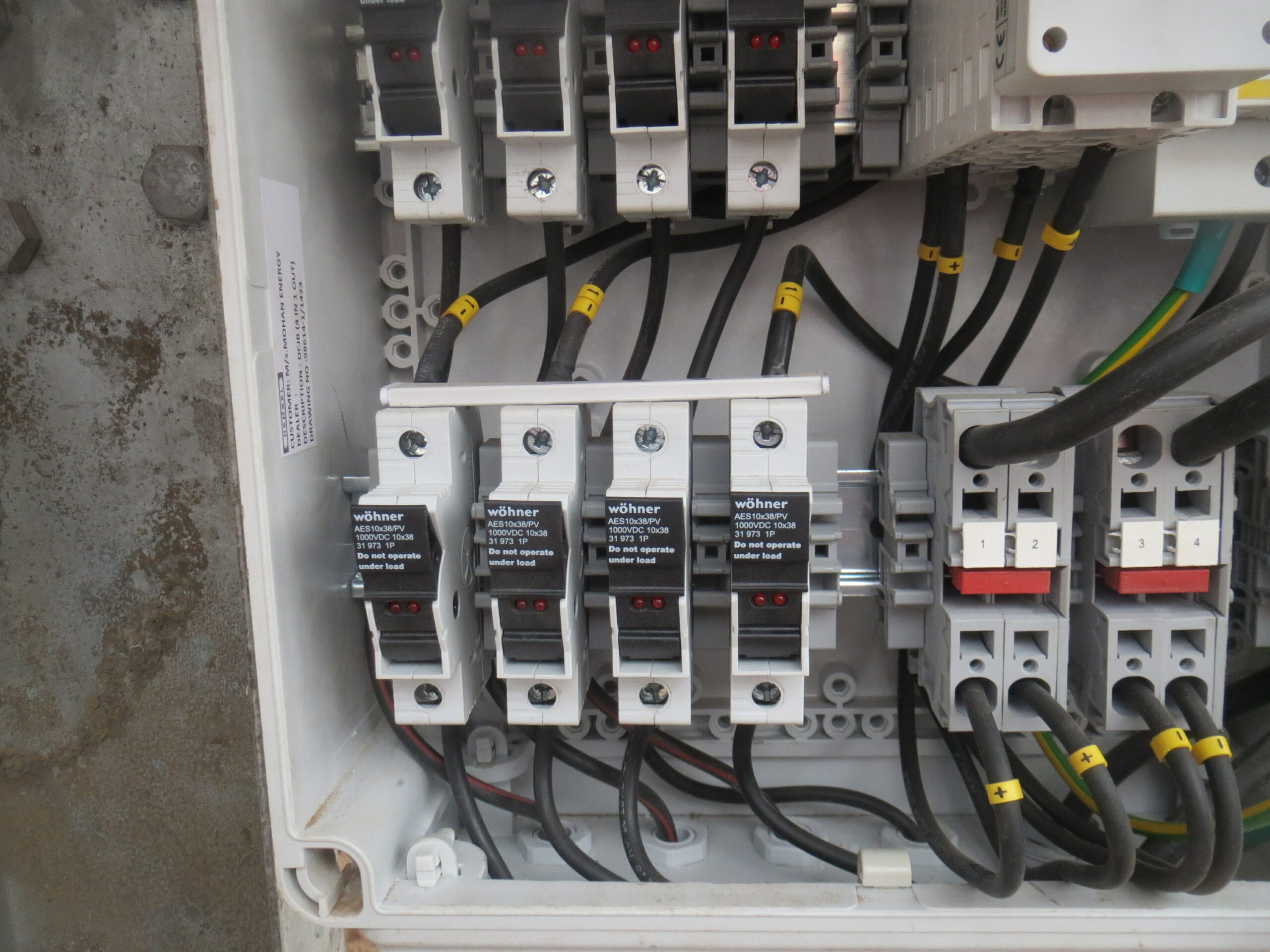The requirements for DC overcurrent protection seem to have changed a lot in the AS/NZS 5033:2021 update upon first glance. But most of these changes are just rearrangement and new notation. This article will explain the old and new requirements.
Skip to:
AS/NZS 5033:2014 requirements
Overcurrent protection requirements were covered almost entirely within Clause 3.3 in AS/NZS 5033:2014.
Clause 3.3.4 explained when string overcurrent protection was required, while Clause 3.3.5.1 listed the sizing requirements for string overcurrent protection.
Clause 3.3.5.2.2 and Clause 3.3.5.2.3 explained when sub-array overcurrent protection was required, while Clause 3.3.5.2.3 listed the sizing requirements for sub-array overcurrent protection.
Clause 3.3.5.3 explained when array overcurrent protection was required, and the relevant sizing requirements.
The formulas were expressed as summarised below.
String overcurrent protection required if:
((SA – 1) × ISC MOD) > IMOD MAX OCPR
String overcurrent protection sizing In must comply with:
In > 1.5 × ISC MOD
In < 2.4 × ISC MOD
In ≤ IMOD MAX OCPR
There’s also an alternative calculation where strings are grouped in parallel, but this was removed in the 2021 version.
Sub-array overcurrent protection required if:
More than two sub-arrays
ISC ARRAY × 1.25 is less than the CCC (current carrying capacity) of any sub-array cable, switching and connection device
Sub-array overcurrent protection sizing In must comply with:
In ≥ 1.25 × ISC S-ARRAY
In ≤ 2.4 × ISC S-ARRAY
Array overcurrent protection required if:
Systems connected to batteries or where other sources of current might feed into the PV array under fault conditions.
Array overcurrent protection sizing In must comply with:
In ≥ 1.25 × ISC ARRAY
In ≤ 2.4 × ISC ARRAY
AS/NZS 5033:2021 requirements
The requirements for overcurrent protection are still covered in Clause 3.3.3 in AS/NZS 5033:2021, but cross-referencing between different sub-clauses becomes important.
Clause 3.3.3.1 explains how to calculate the maximum expected string current, which is used in Clause 3.3.3.2 to calculate the potential string fault current, Clause 3.3.3.3 to calculate the potential sub-array fault current, and in Table 3.1 to calculate the various overcurrent protection ratings.
The calculation of potential string fault current in Clause 3.3.3.2 is then used in Clause 3.3.4.1 to determine if string overcurrent protection is required. There are no explicit requirements to test whether sub-array and array overcurrent protection is required.
Clause 3.3.5 and Table 3.1 gives the sizing requirements for string, sub-array and array overcurrent protection, using values calculated from the previous clauses.
One of the reasons for the rearrangement of clauses in AS/NZS 5033:2021 is accommodating the introduction of DCUs (DC conditioning units) into the calculations. Clause 3.3.3.1 offers three different methods for calculating the maximum string current ISTRING MAX, depending on the presence of DCUs within the string.
Maximum string current where there are no DCUs (3.3.3.1a):
ISTRING MAX = 1.25 × KI × ISC MOD
This is analogous to the AS/NZS 5033:2014 formulas.
Maximum string current where all PV modules have DCUs attached (3.3.3.1c):
ISTRING MAX = IDCU string max
Maximum string current where only some PV modules have DCUs attached (3.3.3.1b):
Whichever of the previous two formulas gives the larger result.
The sizing requirements in Table 3.1 for all three types of overcurrent protection are then based on the calculated ISTRING MAX.
String overcurrent protection sizing In must comply with:
Where there are no DCUs:
1.2 × ISTRING MAX < In ≤ IMOD MAX OCPR
Where all PV modules have DCUs attached:
ISTRING MAX < In ≤ IDCU OCPR
Where only some PV modules have DCUs attached:
Comply with both of the previous two formulas.
Sub-array overcurrent protection sizing In must comply with:
In ≥ SSA × ISTRING MAX
Array overcurrent protection sizing In must comply with:
In ≥ SA × ISTRING MAX
To work out whether string overcurrent protection is required, an additional calculation of potential string fault current is required, as per Clause 3.3.3.2.
Potential string fault current:
IF STRING = (SA – 1) × ISTRING MAX
If there is only one string, IF STRING = ISTRING MAX.
Whether string overcurrent protection is required, as per Clause 3.3.4.1, is then based on IF STRING.
String overcurrent protection required if:
IF STRING + IBF TOTAL > IMOD MAX OCPR
Clauses 3.3.4.2 and 3.3.4.3 don’t specify situations in which sub-array and array overcurrent protection would be required, just that if they are not used, the cable size will need to be larger as per Clause 4.4.2. Inclusion of sub-array and array overcurrent protection therefore becomes an economic decision, balancing the cost of protection against potentially larger cables.
Comparison of AS/NZS 5033:2014 and AS/NZS 5033:2021 requirements
There are clearly significant changes from the 2014 version to the 2021 version in terms of notation and formula arrangement. AS/NZS 5033:2014 formulas tend to be based around ISC MOD, while the 2021 equivalents tend to be based on ISTRING MAX. However, the numerical results are only slightly changed. There are obviously substantial changes if the system contains DCUs, however if no DCUs are included, the changes to the actual calculations are simply:
- Removal of the 2.4 upper factor for overcurrent ratings
- Inclusion of the KI factor to all formulas
- Inclusion of the 1.25 factor and backfeed current when determining if string overcurrent protection is required
- Removal of explicit requirements for sub-array and array overcurrent protection
Worked example of string overcurrent protection
A PV system has 3 strings of bifacial PV modules, and no DCUs. The modules have a ISC of 9.8 A and an IOCPR of 20 A. The KI factor has been determined to be 1.1, and the inverter has a potential backfeed current of 3 A.
According to AS/NZS 5033:2014, string overcurrent protection is required if:
(SA – 1) × ISC MOD > IMOD MAX OCPR
(3 – 1) × 9.8 A > 20 A
19.6 A > 20 A → FALSE, so string overcurrent protection is not required.
According to AS/NZS 5033:2021, string overcurrent protection is required if:
IF STRING + IBF TOTAL > IMOD MAX OCPR
Which becomes: (SA – 1) × ISTRING MAX + IBF TOTAL > IMOD MAX OCPR
Which becomes: (SA – 1) × 1.25 × KI × ISC MOD + IBF TOTAL > IMOD MAX OCPR
(3 – 1) × 1.25 × 1.1 × 9.8 A + 3 A > 20 A
26.95 A + 3 A > 20 A → TRUE, so string overcurrent protection is required.
The changes from AS/NZS 5033:2014 to AS/NZS 5033:2021 are inclusion of a 1.25 factor, inclusion of the KI factor, and inclusion of the backfeed current. In this example, the changes are significant enough to alter the result of the calculation.
String overcurrent protection sizing, assuming string overcurrent protection is installed:
According to AS/NZS 5033:2014, string overcurrent protection sizing In must comply with:
In > 1.5 × ISC MOD
In < 2.4 × ISC MOD
In ≤ IMOD MAX OCPR
Therefore In must be more than 14.7 A, less than 23.52 A, and less than or equal to 20 A. We would probably choose a 15 A or a 20 A fuse.
According to AS/NZS 5033:2021, string overcurrent protection sizing In must comply with:
1.2 × ISTRING MAX < In ≤ IMOD MAX OCPR
Which becomes: 1.2 × 1.25 × KI × ISC MOD < In ≤ IMOD MAX OCPR
Therefore In must be more than 16.17 A and less than or equal to 20 A. We would probably choose a 20 A fuse.
The only differences from the 2014 requirements are the removal of the 2.4 factor test in the maximum calculation and the inclusion of the 1.1 KI factor in the minimum calculation, because the 1.2 × 1.25 from AS/NZS 5033:2021 is numerically equivalent to 1.5 from AS/NZS 5033:2014. This may or may not affect our final fuse size selection.
Definitions of terms
ISC MOD = short circuit current of a PV module or PV string at STC, as specified by the manufacturer in the product specification plate.
IMOD MAX OCPR = PV module maximum overcurrent protection rating as determined by IEC 61730-2. Also referred to as maximum series fuse rating, or maximum reverse current rating, and can be found on the PV module datasheet.
ISC ARRAY = short circuit current of the array at STC. Equal to ISC MOD × SA.
ISC S-ARRAY = short circuit current of the sub-array at STC. Equal to ISC MOD × SSA.
ISTRING MAX = maximum current in a string, dependant on the PV system configuration. Calculated according to AS/NZS 5033:2021 Clause 3.3.3.1.
IDCU string max = DCU maximum overcurrent protection on the DCU string side.
IDCU OCPR = DCU maximum overcurrent protection rating as determined by the DCU manufacturer.
SSA = total number of parallel connected PV strings in the PV sub-array.
SA = total number of parallel connected PV strings in the PV array.
IF STRING = potential fault current in a string from other parallel strings. Calculated according to AS/NZS 5033:2021 Clause 3.3.3.2.
IBF TOTAL = the sum of all backfeed sources of current not originating at the PV modules, such as from PCE/s or other external sources that are directly connected to the array. The inverter backfeed short-circuit current, if present, can be obtained from the inverter manufacturer’s installation manual.
More information
Want more information on the AS/NZS 5033:2021 updates? Check out our Deep Dive technical article here, or enrol in our AS/NZS 5033:2021 updates course below.




